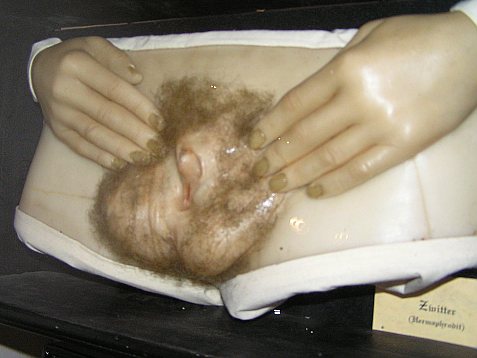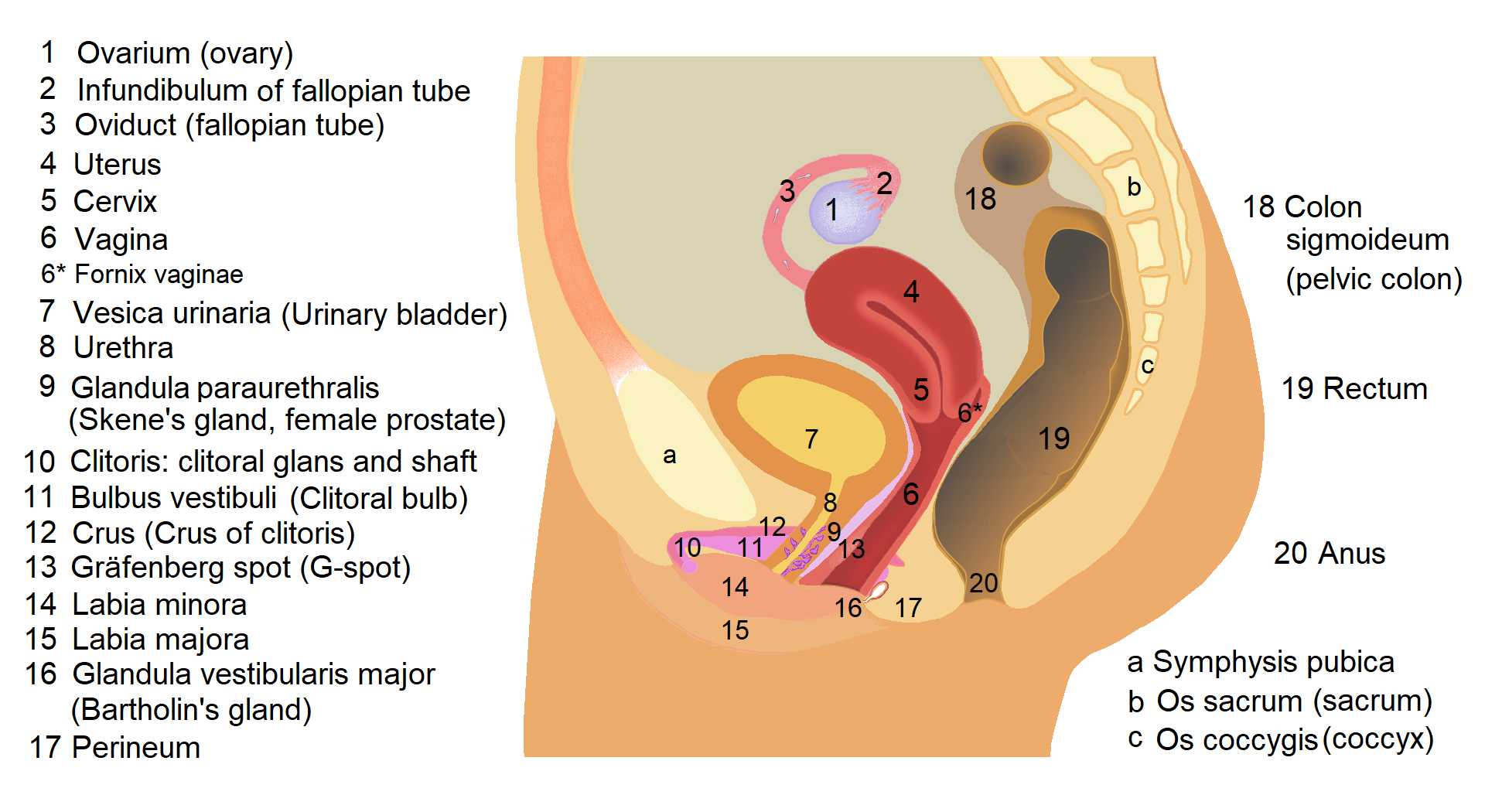|
Hypospadias
Hypospadias is a common malformation in fetal development of the penis in which the urethra does not open from its usual location on the head of the penis. It is the second-most common birth defect of the male reproductive system, affecting about one of every 250 males at birth, although when including milder cases, is found in up to 4% of newborn males. Roughly 90% of cases are the less serious distal hypospadias, in which the urethral opening (the Urinary meatus, meatus) is on or near the head of the penis (Glans penis, glans). The remainder have proximal hypospadias, in which the meatus is all the way back on the shaft of the penis, near or within the scrotum. Shiny tissue or anything that typically forms the urethra instead extends from the meatus to the tip of the glans; this tissue is called the urethral plate. In most cases, the foreskin is less developed and does not wrap completely around the penis, leaving the underside of the glans uncovered. Also, a downward bending of ... [...More Info...] [...Related Items...] OR: [Wikipedia] [Google] [Baidu] |
Disorders Of Sex Development
Disorders of sex development (DSDs), also known as differences in sex development, variations in sex characteristics (VSC), sexual anomalies, or sexual abnormalities, are congenital conditions affecting the reproductive system, in which development of chromosomal, gonadal, or anatomical sex is atypical. DSDs are subdivided into groups in which the labels generally emphasize the karyotype's role in diagnosis: 46,XX; 46,XY; sex chromosome; XX, sex reversal; ovotesticular disorder; and XY, sex reversal. Infants born with atypical genitalia often cause confusion and distress for the family. Psychosexual development is influenced by numerous factors that include, but are not limited to, gender differences in brain structure, genes associated with sexual development, prenatal androgen exposure, interactions with family, and cultural and societal factors. Because of the complex and multifaceted factors involved, communication and psychosexual support are all important. A team of e ... [...More Info...] [...Related Items...] OR: [Wikipedia] [Google] [Baidu] |
Cryptorchidism
Cryptorchidism, also known as undescended testis, is the failure of one or both testes to descend into the scrotum. The word is . It is the most common birth defect of the male genital tract. About 3% of full-term and 30% of premature infant boys are born with at least one undescended testis. However, about 80% of cryptorchid testes descend by the first year of life (the majority within three months), making the true incidence of cryptorchidism around 1% overall. Cryptorchidism may develop after infancy, sometimes as late as young adulthood, but that is exceptional. Cryptorchidism is distinct from monorchism, the condition of having only one testicle. Though the condition may occur on one or both sides, it more commonly affects the right testis. A testis absent from the normal scrotal position may be: # Anywhere along the "path of descent" from high in the posterior (retroperitoneal) abdomen, just below the kidney, to the inguinal ring # In the inguinal canal # Ectopic, havin ... [...More Info...] [...Related Items...] OR: [Wikipedia] [Google] [Baidu] |
Chordee
Chordee is a condition in which the Glans penis, head of the Human penis, penis curves downward or upward, at the junction of the head and Body of penis, shaft of the penis. The curvature is usually most obvious during erection, but resistance to straightening is often apparent in the Tumescence, flaccid state as well. In many cases but not all, chordee is associated with hypospadias. This is not the same condition as Peyronie's disease, which involves curvature of the shaft of the penis most commonly due to injury during adult life. Signs and symptoms It is usually considered a congenital malformation of unknown cause. Since at an early stage of fetal development the penis is curved downward, it has been proposed that chordee results from an arrest of penile development at that stage. The curvature of a chordee can involve # tethering of the skin with urethra and corpora of normal size; # curvature induced by fibrosis and contracture of the fascial tissue (Buck's fascia or Darto ... [...More Info...] [...Related Items...] OR: [Wikipedia] [Google] [Baidu] |
Undescended Testicle
Cryptorchidism, also known as undescended testis, is the failure of one or both testes to descend into the scrotum. The word is . It is the most common birth defect of the male genital tract. About 3% of full-term and 30% of premature infant boys are born with at least one undescended testis. However, about 80% of cryptorchid testes descend by the first year of life (the majority within three months), making the true incidence of cryptorchidism around 1% overall. Cryptorchidism may develop after infancy, sometimes as late as young adulthood, but that is exceptional. Cryptorchidism is distinct from monorchism, the condition of having only one testicle. Though the condition may occur on one or both sides, it more commonly affects the right testis. A testis absent from the normal scrotal position may be: # Anywhere along the "path of descent" from high in the posterior (retroperitoneal) abdomen, just below the kidney, to the inguinal ring # In the inguinal canal # Ectopic, havin ... [...More Info...] [...Related Items...] OR: [Wikipedia] [Google] [Baidu] |
Ambiguous Genitalia
Intersex people are those born with any of several Sexual characteristics, sex characteristics, including chromosome patterns, gonads, or sex organ, genitals that, according to the Office of the United Nations High Commissioner for Human Rights, "do not fit typical binary notions of male or female bodies". Sex assignment at birth usually aligns with a child's external genitalia. The number of births with ambiguous genitals is in the range of 1:4,500–1:2,000 (0.02%–0.05%). Other conditions involve the development of atypical chromosomes, gonads, or hormones. The portion of the population that is intersex has been reported differently depending on which definition of intersex is used and which conditions are included. Estimates range from 0.018% (one in 5,500 births) to 1.7%. The difference centers on whether conditions in which chromosomal sex matches a phenotypic sex which is clearly identifiable as male or female, such as late onset congenital adrenal hyperplasia (1.5 ... [...More Info...] [...Related Items...] OR: [Wikipedia] [Google] [Baidu] |
Urinary Meatus
The urinary meatus (, ; : meati or meatuses), also known as the external urethral orifice, is the opening of the penis or vulva where urine exits the urethra during urination. It is also where semen exits during male ejaculation, and other fluids during female ejaculation. The meatus has varying degrees of sensitivity to touch. In human males The male external urethral orifice is the external opening of the urethra, normally located at the tip of the glans penis, at its junction with the frenular delta. It presents as a vertical slit, and continues longitudinally along the front aspect of the glans, which facilitates micturition. In some cases, the opening may be more rounded. This can occur naturally or may also occur as a side effect of excessive skin removal during circumcision. The meatus is a sensitive part of the male reproductive system. In human females The female external urethral orifice is where urine exits the urethra during urination. It is located about behin ... [...More Info...] [...Related Items...] OR: [Wikipedia] [Google] [Baidu] |
Circumcision
Circumcision is a procedure that removes the foreskin from the human penis. In the most common form of the operation, the foreskin is extended with forceps, then a circumcision device may be placed, after which the foreskin is excised. Topical or locally injected anesthesia is generally used to reduce pain and physiologic stress. Circumcision is generally electively performed, most commonly done as a form of preventive healthcare, as a religious obligation, or as a cultural practice. It is also an option for cases of phimosis, other pathologies that do not resolve with other treatments, and chronic urinary tract infections (UTIs). The procedure is contraindicated in cases of certain genital structure abnormalities or poor general health. The procedure is associated with reduced rates of sexually transmitted infections and urinary tract infections. This includes reducing the incidence of cancer-causing forms of human papillomavirus (HPV) and reducing HIV transmi ... [...More Info...] [...Related Items...] OR: [Wikipedia] [Google] [Baidu] |
Urethroplasty
Urethroplasty is the surgical repair of an injury or defect within the walls of the urethra. Trauma, iatrogenic injury and infections are the most common causes of urethral injury/defect requiring repair. Urethroplasty is regarded as the gold standard treatment for urethral strictures and offers better outcomes in terms of recurrence rates than dilatations and urethrotomies. It is probably the only useful modality of treatment for long and complex strictures though recurrence rates are higher for this difficult treatment group. There are four commonly used types of urethroplasty performed; anastomotic, buccal mucosal onlay graft, scrotal or penile island flap, and Johansen's urethroplasty. With an average operating room time of between three and eight hours, urethroplasty is not considered a minor operation. Patients who undergo a shorter duration procedure may have the convenience of returning home that same day (between 20% and 30% in total of urethroplasty patients). Ho ... [...More Info...] [...Related Items...] OR: [Wikipedia] [Google] [Baidu] |
Penoscrotal Transposition
Penoscrotal transposition (PST) is a group of congenital defects involving an abnormal spatial arrangement of penis and scrotum In most terrestrial mammals, the scrotum (: scrotums or scrota; possibly from Latin ''scortum'', meaning "hide" or "skin") or scrotal sac is a part of the external male genitalia located at the base of the penis. It consists of a sac of skin .... Types There are two types of penoscrotal transposition. * Complete penoscrotal transposition * Incomplete penoscrotal transposition In incomplete penoscrotal transposition, penis is located in the middle of the scrotum, but in complete transposition, penis is located in the perineum. Causes Treatment Gold standard of PST treatment is surgical repair. Repair technique of penoscrotal transposition included a Glenn–Anderson technique, which is developed by F. Glenn and E. Everett Anderson. References {{Med-stub Congenital disorders of urinary system Congenital disorders of male genital orga ... [...More Info...] [...Related Items...] OR: [Wikipedia] [Google] [Baidu] |
Birth Defect
A birth defect is an abnormal condition that is present at birth, regardless of its cause. Birth defects may result in disabilities that may be physical, intellectual, or developmental. The disabilities can range from mild to severe. Birth defects are divided into two main types: structural disorders in which problems are seen with the shape of a body part and functional disorders in which problems exist with how a body part works. Functional disorders include metabolic and degenerative disorders. Some birth defects include both structural and functional disorders. Birth defects may result from genetic or chromosomal disorders, exposure to certain medications or chemicals, or certain infections during pregnancy. Risk factors include folate deficiency, drinking alcohol or smoking during pregnancy, poorly controlled diabetes, and a mother over the age of 35 years old. Many birth defects are believed to involve multiple factors. Birth defects may be visible at birth or dia ... [...More Info...] [...Related Items...] OR: [Wikipedia] [Google] [Baidu] |
Urethra
The urethra (: urethras or urethrae) is the tube that connects the urinary bladder to the urinary meatus, through which Placentalia, placental mammals Urination, urinate and Ejaculation, ejaculate. The external urethral sphincter is a striated muscle that allows voluntary control over urination. The Internal urethral sphincter, internal sphincter, formed by the involuntary smooth muscles lining the bladder neck and urethra, receives its nerve supply by the Sympathetic nervous system, sympathetic division of the autonomic nervous system. The internal sphincter is present both in males and females. Structure The urethra is a fibrous and muscular tube which connects the urinary bladder to the external urethral meatus. Its length differs between the sexes, because it passes through the penis in males. Male In the human male, the urethra is on average long and opens at the end of the external urethral meatus. The urethra is divided into four parts in men, named after the lo ... [...More Info...] [...Related Items...] OR: [Wikipedia] [Google] [Baidu] |







